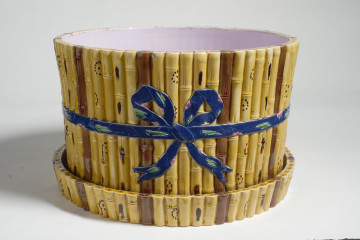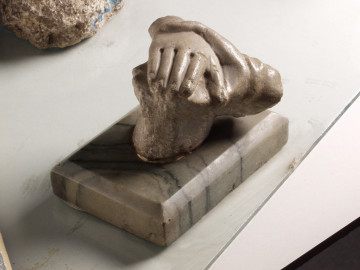
Cover
XIX/XX wiek, 2nd half of the 19th century
Castle Museum in Łańcut
Part of the collection: Ceramics
Cache-pôt from a pair of majolica pots made in the famous English ceramics factory Minton & Co in Stoke-on-Trent, operating since the end of the 18th century. This factory was a major producer of majolica in Victorian England, m.in. cache-pôt vessels used to insert flowerpots.
The Łańcut cache-pôt is a large, thick-walled cylindrical vessel with a base. The outer surface of the walls is modeled in the shape of bundles of bamboo stems tied with a ribbon with a bow. The stems are painted naturalistically, in yellow and brown. The pot and stand are covered inside with a lilac glaze. The vessel bears the following trademarks: the Minton impression, the design number – 480, the mark for the year 1867.
A pair of pots made in the same year for the Łańcut castle was purchased in the times of Alfred Józef Potocki (1822-1889), the second Ordynat. They were placed in the living room on the first floor of the castle (now the representative Corner Salon). In the times of the last Ordynat, Alfred Potocki, in the twenties of the twentieth century, they stood on tables in the northern corridor on the ground floor of the castle (cf. Barbara Trojnar, Ceramics from the Minton factory in the collection of the Museum-Castle in Łańcut, Łańcut 2021, pp. 13-16, figs. 4, 5).
Barbara Trojnar
Author / creator
Object type
Ceramics
Technique
farby podszkliwne
Material
majolica
Creation time / dating
Owner
Muzeum - Zamek w Łańcucie
Identification number
Location / status

XIX/XX wiek, 2nd half of the 19th century
Castle Museum in Łańcut

XIX century
Castle Museum in Łańcut

XIX/XX wiek
Castle Museum in Łańcut
DISCOVER this TOPIC
Museum of King Jan III's Palace at Wilanów
DISCOVER this PATH
Educational path